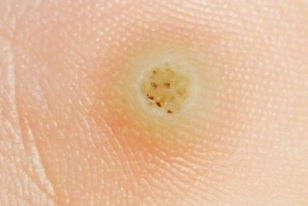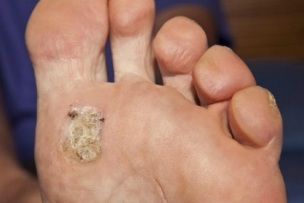
If a hard, rough papule with a rough top appears on the soles of the feet, it is a plantar wart or callus. The differences are important, mainly in the origin and the methods of treatment. The wart grows like a sharp thorn in the inner layer of the skin of the foot, causing severe pain. Doctors recommend removing this swelling of the skin if it is damaged by the shoes and becomes inflamed.
The appearance of the growth on the sole of the foot
The main part of the common wart on the foot grows inward, into the dermis. The reason is that from the outside the tumor is pressed by hard surfaces: shoes, various coatings on which one walks. New growth cells appear from the soft tissues of the skin. In the photo of the plantar wart, a dense plaque or roll is visible from the outside. The surface of the formation is devoid of skin lines, consists of scales of the horny substance. The adjacent skin changes: it becomes denser, covered with a layer of keratin.
What a plantar wart looks like:
- a nodule or plaque raised above the epidermis 1 to 5 mm;
- the shape is round, oval or polygonal;
- the surface is hard and rough to the touch;
- pink, yellow-white or grayish color;
- diameter of the formation from 1 to 20 mm;
- papillary pattern missing;
- well-defined edges.
A wart on the foot is characterized by sharp pain that interferes with walking, until temporary incapacity.

Buildup occurs in areas exposed to intense pressure and sweating. Typical location of the wart on the sole: heels, pads of the foot and toes. Painful and difficult to remove formations appear at the edge of the nail and under the nail plate. Inside all types of warts, there are blood vessels that supply living tissue, cells that multiply intensively. Small black dots are visible on the surface - blood clots in the capillaries; they can bleed when the stratum corneum is cut.
Plantar warts are most common in school-aged children. In about 30% of patients, these formations go away on their own within the first year. However, it is recommended to start treatment as soon as the first symptoms appear, especially if the plantar wart hurts, or if the risk of infection of surrounding people is high. The infection is also dangerous, when a group of formations appears in one area, individual papules merge into a mosaic plaque.
Wart - a manifestation of the papilloma virus
The skin of the feet is often damaged, compressed and sweaty when wearing tight and uncomfortable shoes. If thin-walled blisters with clear liquid inside appear, they are corns. Sometimes a keratin layer forms on the surface, but despite this, the typical skin lines remain.
The appearance of a wart on the soles of the feet goes unnoticed at first or is perceived as the formation of a callus. It is necessary to carefully look at the surface of the formation and pay attention to the characteristic signs. It is severe keratinization, absence of skin lines, pain when the surrounding skin is compressed. These are the results of the active reproduction of the papilloma virus in the living cells of the epithelium.
Causes of plantar warts:
- papillomavirus (HPV) infection;
- weakening of local and general immune defenses;
- activation of the virus, penetration into epithelial cells;
- increased multiplication and rapid keratinization of infected cells.
HPV is spread through household and sexual contact. Infectious agents penetrate even with minor lesions of the skin and mucous membranes: cracks, cuts, oozing.
HPV types 1, 2, 4, 27 and 57 mainly infect cells in the skin of the foot. The plantar type of growths of viral origin belongs to simple formations (ordinary, vulgar). According to the International Classification of Diseases, they are infectious and parasitic diseases. Class ICD-10: "Viral infections characterized by lesions of the skin and mucous membranes. "
Simple warts are benign epithelial tumors. They do not initially present a health hazard. Sometimes such growths undergo malignant transformation into a cancerous tumor. The process is more often triggered by types of HPV for which a high risk of developing cancer is established.
Foot warts treatment
After infection, the incubation period begins: the papilloma virus invades cells, "reformatting" their reproduction and development. Much more often, the infection becomes latent, and in such an inactive state it can exist throughout the life of the organism. Immunity in this case removes the papilloma virus, puts it into sleep mode without special treatment.
Plantar warts may appear 3-10 years later or appear several weeks after infection and then disappear within the first year or within two years.
Not everyone is ready to wait, relying on spontaneous healing and cleansing of the skin of growths. Many go to the doctor at the first sign of an HPV infection. Dermatologists suggest using modern methods of wart removal, recommend means of antiviral therapy, strengthening the immune system of the skin and the whole body.
If for an adequate choice of therapy it is necessary to establish the type of HPV, the doctor prescribes several additional studies. A biopsy is done to collect histological material, an analysis is done to determine antibodies against the papilloma virus.

Processing options:
- The use of special medicines for plantar warts. Dissolution and exfoliation of dead cells occurs.
- Laser excision of simple neoplasms with scab formation, under which healing takes place. The crust disappears 7-10 days after the procedure.
- Cryodestruction with liquid nitrogen. Large warts are removed using several procedures. When exposed to low temperatures, a bubble appears, as after a burn.
- Electrocoagulation using an electrode through which a high frequency current is applied to destroy pathological tissue. Painful procedure accompanied by a strong smell of burning skin.
- Surgical removal.
- Injecting drugs.
At the start of treatment, it is recommended to use a special bandage at home. This affordable remedy is used after softening the wart on the foot with lukewarm water, after cleaning it from the stratum corneum with nail scissors and pumice stone. Then a patch is applied. The treatment lasts an average of 1 to 3 months.
Prevention
Papilloma viruses can persist for a long time in the environment. You have to keep your feet clean and not go without shoes, especially in public locker rooms, bathrooms and in the swimming pool. It is necessary to use special slippers to protect the soles of the feet from contact with surfaces contaminated with particles of the skin of other people. Also, don't wear other people's socks and shoes.
Do not scratch the wart, otherwise similar growths will appear on other parts of the leg.
Papilloma viruses are extremely contagious. Disinfect accessories for daily hygiene and medication applications. Socks and a towel for the feet should be thoroughly washed with hot water, scissors, a nail file, pumice stone should be disinfected. Be sure to wash your hands with soap and water after touching education, various medical procedures.














































































